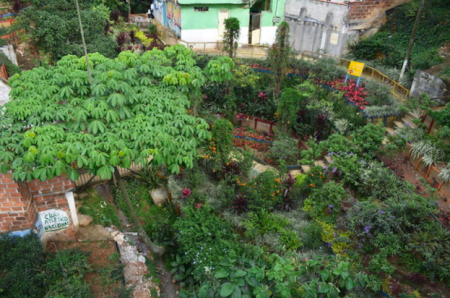
Area characterisation:
Medellín, is located in Colombia and is considered the second most important city in the country after Bogotá, the country's capital. It is the first country in South America, directly after Panama. It is located in the Central Cordillera, one of the three branches of the most important mountain chain in Latin America. This location in the Cordillera de los Andes makes Medellín a city located in a region surrounded by mountains and nature.
Objective:
Medellín, like many other cities, faces rising temperatures, worsened by the urban heat island effect—concrete and tarmac absorbing the sun’s power, radiating it out as heat and keeping the city warm long after the sun has gone down. It doesn’t have to be that way, as Colombia’s second-largest city, Medellín, is showing by embracing nature-based solutions.
With the Green Corridor project, which won the 2019 Ashden Award for Cooling by Nature Award, supported by the Kigali Cooling Efficiency Program and in partnership with Sustainable Energy for All, Medellín’s city authorities transformed the verges of 18 roads and 12 waterways into a green paradise that reduces the impact of the heat island effect.
Potential impacts/benefits:
The effectiveness of this approach is well documented. Urban parks can reduce ambient daytime temperature by an average of approximately 1°C. Milan—which suffered power outages due to demand for air conditioning during the summer heatwave—is planning to plant three million trees by 2050 to reduce the heat island effect and increase air quality. Meanwhile, green roofs can cut energy use by 10 to 15 %. In cities such as Athens, there is evidence that they can reduce high cooling loads in buildings by 66 %. Cooling is created by more shading, cuts to the heat radiated by solid surfaces such as a roads, and water evaporating from plants.
Since the programme started the botanical gardens have trained 75 new gardeners. This has helped people who are most vulnerable, displaced by the armed conflict or from poorer rural communities, to find work. The apprenticeship scheme gives them workplace training as well as a qualification.
Actions:
The Green Corridors project shades cyclists and pedestrians, cools built up areas and cleans the air along busy roads. City authorities have improve the environment of the city by creating green corridors – areas thick with vegetation – along 18 roads and 12 waterways. The city’s botanical gardens train people from disadvantaged backgrounds to become city gardeners and plant technicians. Temperatures have fallen by two or three degrees Celsius in places, with bigger reductions expected in the future.
Design team:
Alcaldía de Medellín
Contacts:
notimedellin.oralidad@medellin.gov.co
https://mercurio.medellin.gov.co/mercurio/inicialPqr.jsp
Awards:
Ashden Winners
Alcaldía de Medellín / Growing a cooler city
Global goals:
-
3. Good Health and well being
-
11. Sustainable cities and communities
-
13. Climate action
-
15. Life on land
NBS goals:
- Enhancing sustainable urbanization
- Restoring ecosystems and their functions
- Developing climate change mitigation
- Developing climate change adaptation
- Improving risk management and resilience
- Urban regeneration through nature-based solutions
- Nature-based solutions for improving well-being in urban areas
- Nature-based solutions for increasing the sustainable use of matter and energy
- Nature-based solutions and the insurance value of ecosystems
- Increasing carbon sequestration through nature-based solutions
NBS benefits:
- Developing climate change adaptation; improving risk management and resilience
- Better protection and restoration of coastal ecosystems
- Flood peak reduction
- Increase infiltration / Water storage
- Reduce drought risk
- Reduce load to sewer system
- Reduce risk of damages from drought
- Reducing temperature at meso or micro scale
- Carbon sequestration and storage
- More energy efficient buildings
- Restoring ecosystems and their functions
- Greater ecological connectivity across urban regenerated sites
- Improve connectivity and functionality of green and blue infrastructures
- Increase achievements of biodiversity targets
- Increase Biodiversity
- Increase quality and quantity of green and blue infrastructures
- Increased cultural richness and biodiversity
- Enhancing sustainable urbanisation
- Changing image of the urban environment
- Creation of green jobs relating to construction & maintenance of NBS
- Improve air quality
- Increase accessibility to green open spaces
- Increase awareness of NBS solution & their effectiveness and co benefits
- Increase communities’ sense of ownership
- Increase population & infrastructures protected by NBS
- Increase well-being